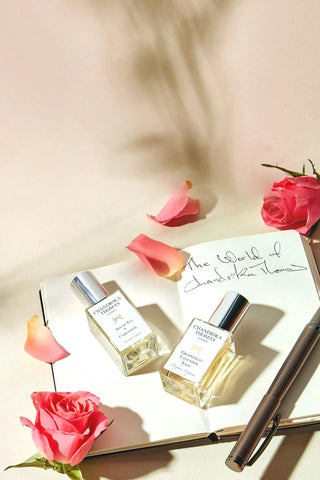It’s easy to think of rosewood as simply a pretty name. But in perfumery, it’s far more than a poetic label. The rosewood scent is subtle, elegant, and quietly polished, an understated note that doesn’t try to impress but always manages to leave an impression.
You won’t find the aroma of roses here. Instead, rosewood smell leans gently floral, slightly woody, and wonderfully soft. It’s the kind of note that smooths the edges, brings a composition into focus, and adds that whisper of finesse you can’t quite put your finger on, but you’d miss it if it weren’t there.
In this note, we’re diving into the world of rosewood: where it comes from, what it smells like, and how it brings a calm, polished strength to Reminisce Smoky & Spicy Patchouli, a fragrance built on contrast, warmth, and a subtle trail of mystery.

Rosewood:
Origins and Fragrance Heritage
In the world of natural materials, rosewood holds a somewhat mythical status, coveted not only by perfumers but also by fine furniture makers and craftsmen. Traditionally, the term refers to various richly coloured hardwoods from the Dalbergia genus, including Brazilian and Indian rosewood. However, in perfumery, rosewood most commonly points to the essential oil extracted from Aniba rosaeodora, a tree native to the Amazon.
This oil, sometimes called bois de rose, is steam-distilled from the wood of the tree and offers a fragrance that’s far more delicate than the name might suggest.
Historically, rosewood oil gained popularity in French perfumery in the early 20th century. It was often used to round out floral compositions and lend a soft sophistication to classic blends. Unfortunately, due to overharvesting, true rosewood is now protected, and many modern fragrances rely on sustainably sourced alternatives or carefully crafted accords to recreate the experience.
And when it’s done well, it’s magical.


What Does Rosewood Smell Like?
So, let’s answer the question properly: how does rosewood smell in a fine fragrance?
It’s not overpowering, not overly floral, and certainly not rosy in the traditional sense. Instead, it offers a clean, smooth profile that’s almost creamy, like polished wood with a hint of petal, warmed by sunlight and softened by air.
Here’s what typically defines the rosewood scent:
-
Delicate woodsiness – A soft, dry wood note that’s never too sharp or earthy.
-
Light floral lift – A faint whisper of something petal-like, think violet or lilac, but subdued.
-
Gentle spice – Just the tiniest hint, almost like a trace of cardamom or clove in the background.
-
Fresh and comforting – Rosewood adds balance. It brings clarity, but with warmth.
It’s often used not to stand out, but to bring everything else together, like a well-cut lining inside a tailored jacket. You may not see it, but you feel the difference it makes.

Rosewood in Reminisce Smoky & Spicy Patchouli
Now, onto Reminisce Smoky & Spicy Patchouli, a fragrance that thrives on contrast. From the very first impression, it’s bold: jasmine and nutmeg introduce themselves with spice and softness. The heart deepens with patchouli, sandalwood, and the smooth richness of myrrh.
And then, rosewood enters. Not loudly, but with a quiet confidence that shapes the dry down. It softens the smoke, warms the spice, and lends a silky finish to the composition. Without it, the fragrance might be too sharp, too dry, too forceful. But with rosewood, it becomes something far more refined, structured, elegant, and quietly seductive.
It’s the finishing touch that doesn’t draw attention to itself. But it gives the perfume its poise.

Why Perfumers Turn to Rosewood
Rosewood isn’t dramatic. It doesn’t demand centre stage. But perfumers love it for that very reason. It’s the note that brings a sense of cohesion, lifting florals, calming spices, and blending beautifully into woody or ambered bases.
You’ll often find rosewood used to:
-
Round out floral bouquets, especially roses, violets, and irises
-
Soften woody or spicy compositions that might otherwise feel harsh
-
Add a refined lift to vintage-style or comforting fragrances
It’s especially useful in modern niche perfumery, where softness and subtlety are valued as much as power.
 Rosewood is the kind of note that works in whispers, never theatrics, adding poise, polish, and depth where it matters most. In Reminisce Smoky & Spicy Patchouli, its presence is quiet yet undeniable. It rounds off the edges, anchors the warmth, and lets the bolder notes unfold with grace.
Rosewood is the kind of note that works in whispers, never theatrics, adding poise, polish, and depth where it matters most. In Reminisce Smoky & Spicy Patchouli, its presence is quiet yet undeniable. It rounds off the edges, anchors the warmth, and lets the bolder notes unfold with grace.
If you've yet to discover the beauty of rosewood in perfumery, this is your moment. Refined, composed, and utterly timeless, it’s a detail that changes everything.



